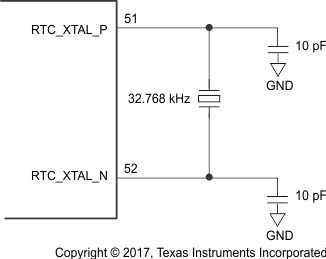SWAS034A February 2017 – May 2021 CC3120
PRODUCTION DATA
- 1 Features
- 2 Applications
- 3 Description
- 4 Functional Block Diagrams
- 5 Revision History
- 6 Device Comparison
- 7 Terminal Configuration and Functions
-
8 Specifications
- 8.1 Absolute Maximum Ratings
- 8.2 ESD Ratings
- 8.3 Power-On Hours (POH)
- 8.4 Recommended Operating Conditions
- 8.5 Current Consumption Summary
- 8.6 TX Power and IBAT versus TX Power Level Settings
- 8.7 Brownout and Blackout Conditions
- 8.8 Electrical Characteristics (3.3 V, 25°C)
- 8.9 WLAN Receiver Characteristics
- 8.10 WLAN Transmitter Characteristics
- 8.11 WLAN Filter Requirements
- 8.12 Thermal Resistance Characteristics
- 8.13 Reset Requirement
- 8.14
Timing and Switching Characteristics
- 8.14.1 Power Supply Sequencing
- 8.14.2 Device Reset
- 8.14.3 Reset Timing
- 8.14.4 Wakeup From HIBERNATE Mode
- 8.14.5 Clock Specifications
- 8.14.6 Interfaces
- 8.15 External Interfaces
- 9 Detailed Description
- 10Applications, Implementation, and Layout
- 11Device and Documentation Support
- 12Mechanical, Packaging, and Orderable Information
8.14.5.1 Slow Clock Using Internal Oscillator
The RTC crystal connected on the device supplies the free-running slow clock. The accuracy of the slow clock frequency must be 32.768 kHz ±150 ppm. In this mode of operation, the crystal is tied between RTC_XTAL_P (pin 51) and RTC_XTAL_N (pin 52) with a suitable load capacitance to meet the ppm requirement.
Figure 8-9 shows the crystal connections for the slow clock.
 Figure 8-9 RTC Crystal Connections
Figure 8-9 RTC Crystal Connections
Section 8.14.5.1.1 lists the RTC crystal requirements.